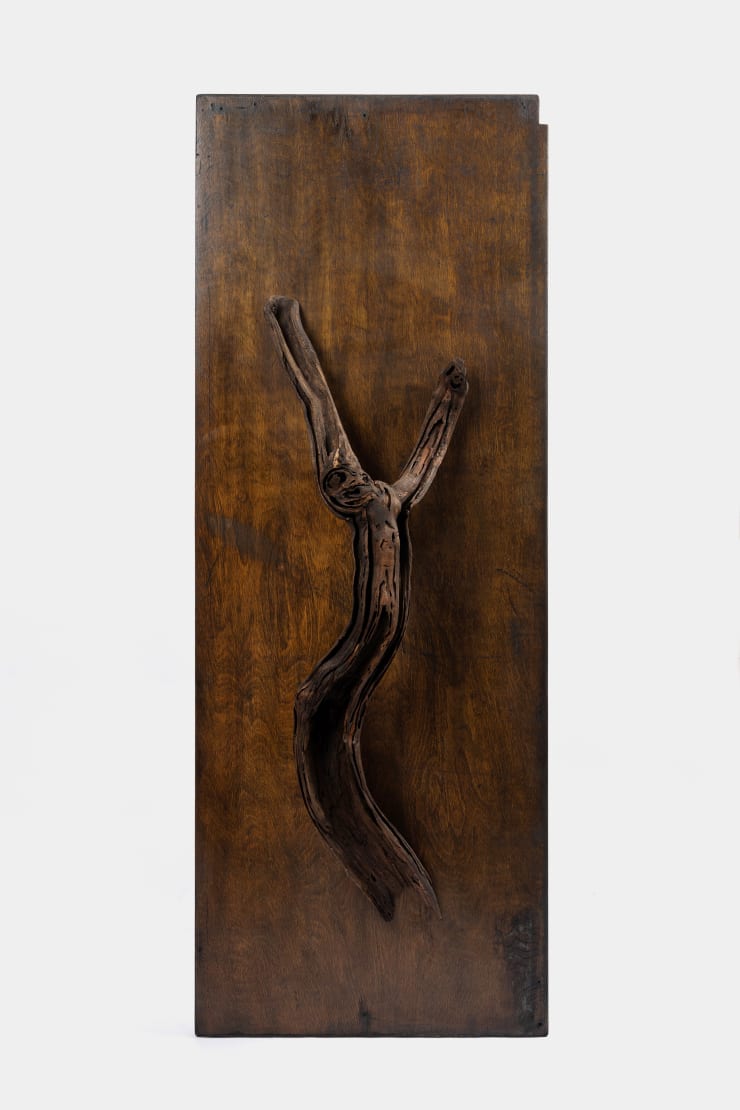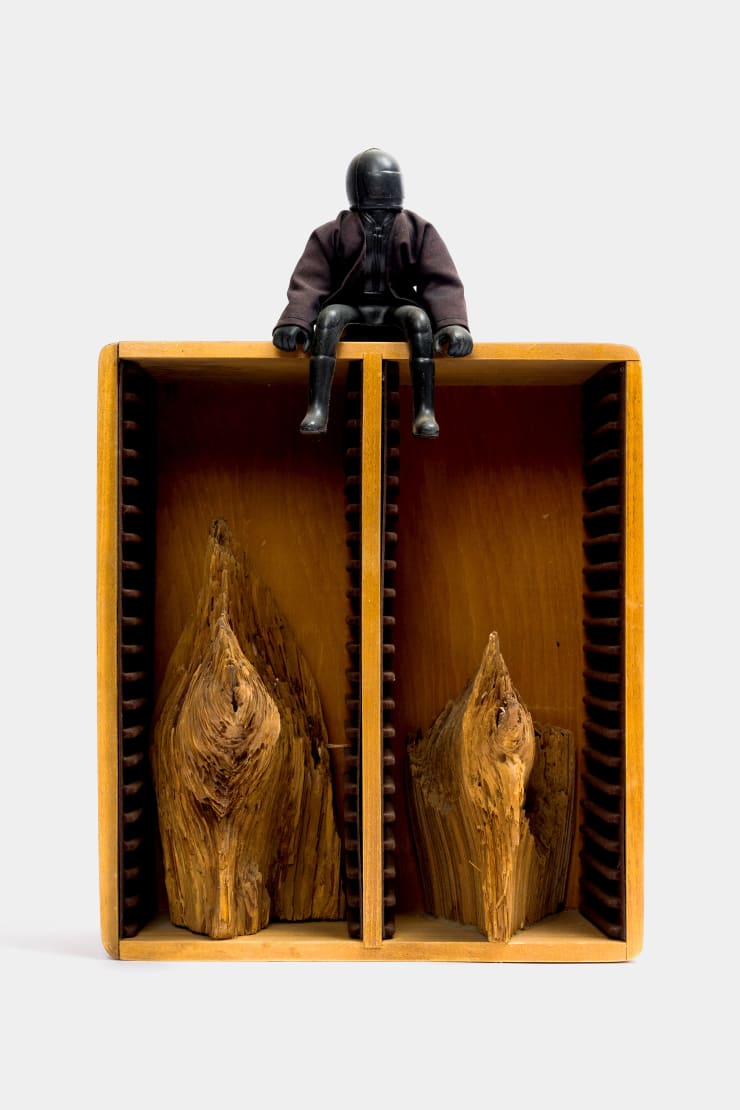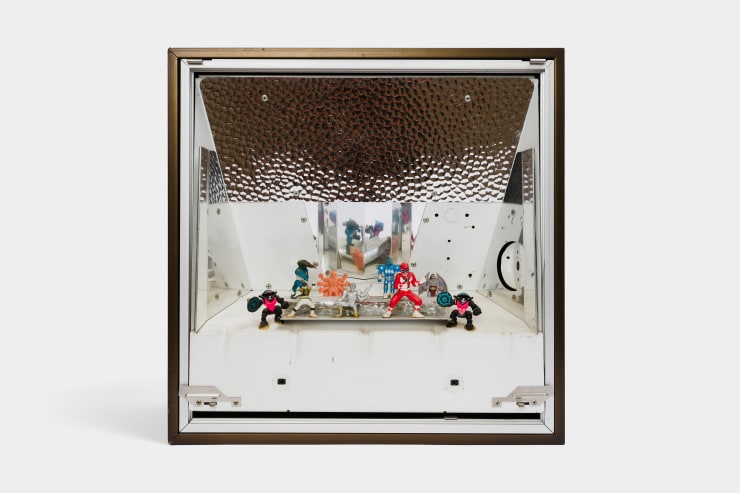Kenzi Shiokava
 Kenzi ShiokavaAngel Kachina, 2003Douglas-fir molding wood and box, metal, paint75 x 16 1/2 x 8 in
Kenzi ShiokavaAngel Kachina, 2003Douglas-fir molding wood and box, metal, paint75 x 16 1/2 x 8 in
190.5 x 41.9 x 20.3 cm Kenzi ShiokavaCorporate Spirit 2, 1998Pine, metal, wire81 x 20 x 20 in
Kenzi ShiokavaCorporate Spirit 2, 1998Pine, metal, wire81 x 20 x 20 in
205.7 x 50.8 x 50.8 cm Kenzi ShiokavaLA Kachina, 2003Douglas-fir molding wood boxes, paint78 x 16 x 12 in
Kenzi ShiokavaLA Kachina, 2003Douglas-fir molding wood boxes, paint78 x 16 x 12 in
198.1 x 40.6 x 30.5 cm Kenzi ShiokavaPrimal Totem X, 1999Douglas-fir post wood84 1/2 x 22 1/2 x 13 in
Kenzi ShiokavaPrimal Totem X, 1999Douglas-fir post wood84 1/2 x 22 1/2 x 13 in
214.6 x 57.1 x 33 cm Kenzi ShiokavaUntitled (Shaman Series), 2000Shells, leather, wood74 x 12 x 12 in
Kenzi ShiokavaUntitled (Shaman Series), 2000Shells, leather, wood74 x 12 x 12 in
188 x 30.5 x 30.5 cm Kenzi ShiokavaUntitled (Primal Totem Series), 1986Salvaged Southern Pine telephone pole wood107 x 12 x 13 in
Kenzi ShiokavaUntitled (Primal Totem Series), 1986Salvaged Southern Pine telephone pole wood107 x 12 x 13 in
271.8 x 30.5 x 33 cm Kenzi ShiokavaUntitled (Shaman Series) , n.d.Glass, shell, yarn, pine wood62 x 12 1/2 x 11 1/2 in
Kenzi ShiokavaUntitled (Shaman Series) , n.d.Glass, shell, yarn, pine wood62 x 12 1/2 x 11 1/2 in
157.5 x 31.8 x 29.2 cm Kenzi ShiokavaUntitled (Shaman Series), 2005Beads, wood, macrame80 x 18 x 18 in
Kenzi ShiokavaUntitled (Shaman Series), 2005Beads, wood, macrame80 x 18 x 18 in
203.2 x 45.7 x 45.7 cm Kenzi ShiokavaUntitled, n.d.Woven fabric, feathers and seed pods on metal strip mounted in wood40 x 21 x 7 in
Kenzi ShiokavaUntitled, n.d.Woven fabric, feathers and seed pods on metal strip mounted in wood40 x 21 x 7 in
101.6 x 53.3 x 17.8 cm Kenzi ShiokavaUntitled, 2005Wire, palm, wood painted bucket72 x 11 in
Kenzi ShiokavaUntitled, 2005Wire, palm, wood painted bucket72 x 11 in
182.9 x 27.9 cm Kenzi ShiokavaKimono, 2010Wood, paint, sign skin74 x 36 x 1 1/4 in
Kenzi ShiokavaKimono, 2010Wood, paint, sign skin74 x 36 x 1 1/4 in
188 x 91.4 x 3.2 cm Kenzi ShiokavaUntitled, n.d.Wood, dried botanical80 x 30 x 9 1/2 in
Kenzi ShiokavaUntitled, n.d.Wood, dried botanical80 x 30 x 9 1/2 in
203.2 x 76.2 x 24.1 cm Kenzi ShiokavaUntitled, 1998Wood, plastic fruit, found objects44 x 30 1/2 x 9 1/2 in
Kenzi ShiokavaUntitled, 1998Wood, plastic fruit, found objects44 x 30 1/2 x 9 1/2 in
111.8 x 77.5 x 24.1 cm Kenzi ShiokavaUntitled, 2000Synthetic apples mounted in metal shelf42 x 34 1/4 x 12 in
Kenzi ShiokavaUntitled, 2000Synthetic apples mounted in metal shelf42 x 34 1/4 x 12 in
106.7 x 87 x 30.5 cm Kenzi ShiokavaUntitled, 1978Wood30 x 32 x 30 in
Kenzi ShiokavaUntitled, 1978Wood30 x 32 x 30 in
76.2 x 81.3 x 76.2 cm Kenzi ShiokavaUntitled, 1997CD case, dried wood, toy figurine16 x 11 1/2 x 10 1/2 in
Kenzi ShiokavaUntitled, 1997CD case, dried wood, toy figurine16 x 11 1/2 x 10 1/2 in
40.6 x 29.2 x 26.7 cm Kenzi ShiokavaUntitled, n.d.Wood shelf, toy figurines, seashell, faux grapes, and leaves13 1/2 x 17 1/2 x 5 1/2 in
Kenzi ShiokavaUntitled, n.d.Wood shelf, toy figurines, seashell, faux grapes, and leaves13 1/2 x 17 1/2 x 5 1/2 in
34.3 x 44.5 x 14 cm Kenzi ShiokavaUntitled, n.d.Metal, botanical, painted wood15 1/2 x 12 1/2 x 8 in
Kenzi ShiokavaUntitled, n.d.Metal, botanical, painted wood15 1/2 x 12 1/2 x 8 in
39.4 x 31.8 x 20.3 cm Kenzi ShiokavaUntitled, 1998Plastic figurine, metal box, plastic skull14 x 8 1/8 x 5 1/2 in
Kenzi ShiokavaUntitled, 1998Plastic figurine, metal box, plastic skull14 x 8 1/8 x 5 1/2 in
35.6 x 20.6 x 14 cm Kenzi ShiokavaUntitled, n.d.Cassette case, plastic figures8 x 13 1/2 x 2 in
Kenzi ShiokavaUntitled, n.d.Cassette case, plastic figures8 x 13 1/2 x 2 in
20.3 x 34.3 x 5.1 cm Kenzi ShiokavaUntitled, n.d.Paint on plastic, metal19 ½ x 18 ⅞ x 3 ⅜ in
Kenzi ShiokavaUntitled, n.d.Paint on plastic, metal19 ½ x 18 ⅞ x 3 ⅜ in
49.5 x 47.8 x 8.6 cm Kenzi ShiokavaUntitled ('Let it Be' Series), 2007Bread box, toy figurines9 5/8 x 17 x 10 in
Kenzi ShiokavaUntitled ('Let it Be' Series), 2007Bread box, toy figurines9 5/8 x 17 x 10 in
24.4 x 43.2 x 25.4 cm Kenzi ShiokavaUntitled (Let it Be Series), 2007Wood, plastic toy figurines18 x 18 x 6 in
Kenzi ShiokavaUntitled (Let it Be Series), 2007Wood, plastic toy figurines18 x 18 x 6 in
45.7 x 45.7 x 15.2 cm![Kenzi Shiokava Untitled (Let it Be Series), 2005 Bread box, toy figurines [Metal box, toy figurines] 10 x 17 x 10 in 25.4 x 43.2 x 25.4 cm](data:image/gif;base64,R0lGODlhAQABAIAAAAAAAP///yH5BAEAAAAALAAAAAABAAEAAAIBRAA7) Kenzi ShiokavaUntitled (Let it Be Series), 2005Bread box, toy figurines [Metal box, toy figurines]10 x 17 x 10 in
Kenzi ShiokavaUntitled (Let it Be Series), 2005Bread box, toy figurines [Metal box, toy figurines]10 x 17 x 10 in
25.4 x 43.2 x 25.4 cm Kenzi ShiokavaUntitled (Let It Be Series) , 2005Wood box, toy figurines24 x 15 1/2 x 4 1/2 in
Kenzi ShiokavaUntitled (Let It Be Series) , 2005Wood box, toy figurines24 x 15 1/2 x 4 1/2 in
61 x 39.4 x 11.4 cm Kenzi ShiokavaUntitled, n.d.Metal, dried oranges, rock, cement10 1/2 x 15 x 2 1/4 in
Kenzi ShiokavaUntitled, n.d.Metal, dried oranges, rock, cement10 1/2 x 15 x 2 1/4 in
26.7 x 38.1 x 5.7 cm Kenzi ShiokavaUntitled, n.d.Paperbox, plastic figurine, dried pomegranate11 x 8 x 6 in
Kenzi ShiokavaUntitled, n.d.Paperbox, plastic figurine, dried pomegranate11 x 8 x 6 in
27.9 x 20.3 x 15.2 cm Kenzi ShiokavaUntitled, n.d.Eggshells, dried paint, cardboard10 x 8 x 3 1/2 in
Kenzi ShiokavaUntitled, n.d.Eggshells, dried paint, cardboard10 x 8 x 3 1/2 in
25.4 x 20.3 x 8.9 cm Kenzi ShiokavaUntitled, 1998Plastic CD case, Soviet wrestler figurine and religious figurines29 x 5 1/4 x 5 in
Kenzi ShiokavaUntitled, 1998Plastic CD case, Soviet wrestler figurine and religious figurines29 x 5 1/4 x 5 in
73.7 x 13.3 x 12.7 cm Kenzi ShiokavaUntitled, n.d.Wood, toy figures7 3/4 x 11 1/2 x 2 3/8 in
Kenzi ShiokavaUntitled, n.d.Wood, toy figures7 3/4 x 11 1/2 x 2 3/8 in
19.7 x 29.2 x 6 cm Kenzi ShiokavaUntitled, n.d.Dried botanicals, found objects, and glass jars on wood shelf57 1/2 x 7 3/4 x 6 in
Kenzi ShiokavaUntitled, n.d.Dried botanicals, found objects, and glass jars on wood shelf57 1/2 x 7 3/4 x 6 in
146.1 x 19.7 x 15.2 cm Kenzi ShiokavaUntitled, c. 2000Wood box, ceramic head19 x 16 x 14 1/2 in
Kenzi ShiokavaUntitled, c. 2000Wood box, ceramic head19 x 16 x 14 1/2 in
48.3 x 40.6 x 36.8 cm Kenzi ShiokavaUntitled, n.d.Stone, dried branches, fruit29 x 16 1/2 x 10 in
Kenzi ShiokavaUntitled, n.d.Stone, dried branches, fruit29 x 16 1/2 x 10 in
73.7 x 41.9 x 25.4 cm Kenzi ShiokavaUntitled, c. 1999Metal, wood, egg, plant22 1/2 x 16 x 10 in
Kenzi ShiokavaUntitled, c. 1999Metal, wood, egg, plant22 1/2 x 16 x 10 in
57.1 x 40.6 x 25.4 cm Kenzi ShiokavaUnititled, n.d.Light fixture, plastic toys19 1/2 x 19 1/2 x 10 in
Kenzi ShiokavaUnititled, n.d.Light fixture, plastic toys19 1/2 x 19 1/2 x 10 in
49.5 x 49.5 x 25.4 cm Kenzi ShiokavaSources, 1969Painted cardboard tray, dried cactus fruits, and mushroom on wood base17 1/2 x 9 x 5 in
Kenzi ShiokavaSources, 1969Painted cardboard tray, dried cactus fruits, and mushroom on wood base17 1/2 x 9 x 5 in
44.5 x 22.9 x 12.7 cm Kenzi ShiokavaUntitled, c. 2000Metal drawer, plastic figure and stone12 1/2 x 17 1/2 x 8 in
Kenzi ShiokavaUntitled, c. 2000Metal drawer, plastic figure and stone12 1/2 x 17 1/2 x 8 in
31.8 x 44.5 x 20.3 cm Kenzi ShiokavaUntitled, n.d.Plastic figurines, metal18 1/4 x 23 3/4 x 8 1/2 in
Kenzi ShiokavaUntitled, n.d.Plastic figurines, metal18 1/4 x 23 3/4 x 8 1/2 in
46.4 x 60.3 x 21.6 cm Kenzi ShiokavaUntitled, n.d.Wood, paint, vintage building blocks24 1/2 x 23 x 3 1/2 in
Kenzi ShiokavaUntitled, n.d.Wood, paint, vintage building blocks24 1/2 x 23 x 3 1/2 in
62.2 x 58.4 x 8.9 cm Kenzi ShiokavaFlight, 1998Metal tray, gardening sticks14 1/2 x 9 3/8 x 4 in
Kenzi ShiokavaFlight, 1998Metal tray, gardening sticks14 1/2 x 9 3/8 x 4 in
36.8 x 23.8 x 10.2 cm Kenzi ShiokavaUntitled, n.d.Metal case, dried botanical37 x 15 x 4 in
Kenzi ShiokavaUntitled, n.d.Metal case, dried botanical37 x 15 x 4 in
94 x 38.1 x 10.2 cm Kenzi ShiokavaUntitled, n.d.19 x 5 7/8 x 2 5/8 in
Kenzi ShiokavaUntitled, n.d.19 x 5 7/8 x 2 5/8 in
48.3 x 14.9 x 6.7 cm Kenzi ShiokavaUntitled, 1976Wood, bone, glass pieces34 x 47 x 6 in
Kenzi ShiokavaUntitled, 1976Wood, bone, glass pieces34 x 47 x 6 in
86.4 x 119.4 x 15.2 cm Kenzi ShiokavaUntitled, n.d.Wire, beads, metal, sequins39 3/8 x 9 1/2 x 9 in
Kenzi ShiokavaUntitled, n.d.Wire, beads, metal, sequins39 3/8 x 9 1/2 x 9 in
100 x 24 x 22.7 cm Kenzi ShiokavaUntitled, n.d.Wire, beads, metal, sequins29 5/8 x 10 3/4 x 8 5/8 in
Kenzi ShiokavaUntitled, n.d.Wire, beads, metal, sequins29 5/8 x 10 3/4 x 8 5/8 in
75.1 x 27.4 x 22 cm Kenzi ShiokavaUntitled, n.d.Metal box, dried painted coconut10 3/4 x 7 1/8 x 2 3/4 in
Kenzi ShiokavaUntitled, n.d.Metal box, dried painted coconut10 3/4 x 7 1/8 x 2 3/4 in
27.3 x 18.1 x 7 cm Kenzi ShiokavaUntitled, 1980Mixed Media29 ¾ x 41 ¾ x 2 ⅜ in
Kenzi ShiokavaUntitled, 1980Mixed Media29 ¾ x 41 ¾ x 2 ⅜ in
75.6 x 106 x 6 cm Kenzi ShiokavaUntitled, 1969mixed media25 1/4 x 19 1/4 in
Kenzi ShiokavaUntitled, 1969mixed media25 1/4 x 19 1/4 in
64.1 x 48.9 cm Kenzi ShiokavaUntitled, 1985Mixed Media35 ¼ x 45 ⅝ x 2 ½ in
Kenzi ShiokavaUntitled, 1985Mixed Media35 ¼ x 45 ⅝ x 2 ½ in
89.5 x 115.9 x 6.3 cm Kenzi ShiokavaUntitled, 2017Dried Dragon tree, plastic32 x 7 x 7 in
Kenzi ShiokavaUntitled, 2017Dried Dragon tree, plastic32 x 7 x 7 in
81.3 x 17.8 x 17.8 cm Kenzi ShiokavaUntitled, n.d.Wood29 x 19 x 10 in
Kenzi ShiokavaUntitled, n.d.Wood29 x 19 x 10 in
73.7 x 48.3 x 25.4 cm Kenzi ShiokavaUntitled, 2005Agave, garden post53 x 21 x 18 in
Kenzi ShiokavaUntitled, 2005Agave, garden post53 x 21 x 18 in
134.6 x 53.3 x 45.7 cm Kenzi ShiokavaUntitled, 2017wood56 x 33 1/2 x 16 1/2 in
Kenzi ShiokavaUntitled, 2017wood56 x 33 1/2 x 16 1/2 in
142.2 x 85.1 x 41.9 cm Kenzi ShiokavaUntitled, n.d.Dried botanicals, electrical wires, and bone on electrical board31 x 21 3/4 x 9 in
Kenzi ShiokavaUntitled, n.d.Dried botanicals, electrical wires, and bone on electrical board31 x 21 3/4 x 9 in
78.7 x 55.2 x 22.9 cm Kenzi ShiokavaUntitled (Elegy Series), 1994Ceramic, nylon, dried leaves on metal58 x 9 1/4 x 4 in
Kenzi ShiokavaUntitled (Elegy Series), 1994Ceramic, nylon, dried leaves on metal58 x 9 1/4 x 4 in
147.3 x 23.5 x 10.2 cm Kenzi ShiokavaUntitled (Elegy Series), 1994Ceramic with dried bamboo leaves in nylon pool filter, mounted on painted burlap, in wood shadow box44 x 15 x 5 1/2 in
Kenzi ShiokavaUntitled (Elegy Series), 1994Ceramic with dried bamboo leaves in nylon pool filter, mounted on painted burlap, in wood shadow box44 x 15 x 5 1/2 in
111.8 x 38.1 x 14 cm
Related artist
Artist Exhibited:
Ulala Imai
Kazuo Kadonaga
Kentaro Kawabata
Zenzaburo Kojima
Kisho Kurokawa
Tadaaki Kuwayama
Toshio Matsumoto
Keita Matsunaga
Yutaka Matsuzawa
Kimiyo Mishima
Kunié Sugiura
Takuro Tamayama
Tiger Tateishi
Sofu Teshigahara
Shomei Tomatsu
Wataru Tominaga
Hosai Matsubayashi XVI
Kansuke Yamamoto
Masaomi Yasunaga
Exhibitions:
-2025-
Sea of Mud, Wall of Flame: Satoru Hoshino and Masaomi Ysunaga
KEY HIRAGA: The Elegant Life of Mr. H
-2024-
KYOKO IDETSU: What can an ideology do for me?
KENTARO KAWABATA / BRUCE NAUMAN
SAORI (MADOKORO) AKUTAGAWA: CENTENARIA
Keita Matsunaga : Accumulation Flow
-2023-
NONAKA-HILL ♥ TATAMI ANTIQUES: A holiday sale of unique objects from Japan
TAKASHI HOMMA : REVOLUTION No.9 / Camera Obscura Studies
TATSUMI HIJIKATA THE LAST BUTOH: Photographs by Yasuo Kuroda
Kiyomizu Rokubey VIII: CERAMIC SIGHT
Masaomi Yasunaga: 石拾いからの発見 / discoveries from picking up stones
SHUZO AZUCHI GULLIVER ‘Synogenesis’
Koichi Enomoto: Against the day
Tatsuo Ikeda / Michael E. Smith
Hiroshi Sugito: the garden with Zenzaburo Kojima
Zenzaburo Kojima: This very green
Tomohisa Obana: To see the rainbow at night, I must make it myself
Daisuke Fukunaga: Beautiful Work
- 2021 -
Natsuyasumi: In the Beginning Was Love
Takashi Homma: mushrooms from the forest
– 2020 –
Hosai Matsubayashi XVI & Trevor Shimizu
Sterling Ruby and Masaomi Yasunaga
– 2019 –
A show about an architectural monograph
Yutaka Matsuzawa
Yutaka Matsuzawa through the lens of Mitsutoshi Hanaga
Takuro Tamayama & Tiger Tateishi
Kunié Sugiura
Masaomi Yasunaga
Miho Dohi
Wataru Tominaga
Naotaka Hiro
Parergon: Japanese Art of the 1980s and 1990s
Tadaaki Kuwayama
– 2018 –
Toshio Matsumoto
Kentaro Kawabata
Kansuke Yamamoto
Kazuo Kadonaga: Wood / Paper / Bamboo / Glass
Press:
-2025-
ARTFORUM, Sawako Goda
Artillery Magazine, Sawako Goda
-2024-
Artsy, Nonaka-Hill
Richesse, Nonaka-Hill Kyoto
Bijutsutecho, Nonaka-Hill Kyoto
The Art Newspaper, Nonaka-Hill Kyoto
Meer, Kyoko Idetsu
Bijyutsutecho, Masaomi Yasunaga
Switch, Masaomi Yasunaga
ARTnews JAPAN, Masaomi Yasunaga
Richesse, Masaomi Yasunaga
Art Basel, Daisuke Fukunaga, Imai Ulala
Art Basel, Kazuo Kadonaga, Sofu Teshigahara
-2023-
ADF webmagazine, Yasuo Kuroda, Tatsumi Hijikata
e-flux, Sanya Kantarofsky, Yasuo Kuroda
Los Angeles Times, Kenzi Shiokava
Artillery, Masaomi Yasunaga
Contemporary Art Daily Shuzo Azuchi Gulliver
- 2022 -
Contemporary Art Daily, Tomohisa Obana
ARTE FUSE, Daisuke Fukunaga
Contemporary Art Daily, Daisuke Fukunaga
Contemporary Art Review Los Angeles (Carla), Daisuke Fukunaga
What's on Los Angeles, Daisuke Fukunaga
Hyperallergic, Daisuke Fukunaga
Artillery, Kentaro Kawabata
Larchmont Buzz, entaro Kawabata
- 2021 -
Art Viewer, Natsuyasumi: In the Beginning Was Love
Hyperallergic, Natsuyasumi: In the Beginning Was Love
Art Viewer, Takashi Homma
Hyperallergic, Busy Work at Home
Art Viewer, Busy Work at Home
Hyperallergic, Ulala Imai
Contemporary Art Review Los Angeles (Carla), Ulala Imai
Contemporary Art Daily, Ulala Imai
artillery, Ulala Imai
Special Ops, Ulala Imai
Art Viewer, Ulala Imai
artillery, Matsubayashi & Trevor Shimizu
– 2020 –
Ceramic Now, Sterling Ryby and Masaomi Yasunaga
Hypebeast, Sterling Ryby and Masaomi Yasunaga
Art Viewer, Sterling Ruby and Masaomi Yasunaga
Air Mail, Sterling Ruby and Masaomi Yasunaga
Los Angeles Times, Kaz Oshiro
ArtnowLA, Kaz Oshiro
What's on Los Angeles, Kaz Oshiro
KCRW, Kaz Oshiro
Tique, Kaz Oshiro
Contemporary Art Daily, Kaz Oshiro
Art Viewer, Kaz Oshiro
Contemporary Art Daily, Sofu Teshigahara
Art Viewer, Sofu Teshigahara
KCRW, Sofu Tsshigahara
Hyperallergic, Nonaka-Hill
Los Angeles Times, Keita Matsunaga
– 2019 –
Los Angeles Times, Tatsumi Hijikata
Art Viewer, Tatsumi Hijikata, Eikoh Hosoe
Contemporary Art Review Los Angeles, Tatsumi Hijikata, Eikoh Hosoe
ArtAsiaPacific, Yutaka Matsuzawa
Los Angeles Times, Tatsumi Hijikata
AUTRE, Tatsumi Hijikata, Eikoh Hosoe
Los Angeles Times, Nonaka-Hill
ARTFORUM, Takuro Tamayama, Tiger Tateishi
Art Viewer, Takuro Tamayama, Tiger Tateishi
KCRW, Nonaka-Hill
LA WEEKLY, Nonaka-Hill
AUTRE, Takuro Tamayama, Tiger Tateishi
ArtsuZe, Takuro Tamayama, Tiger Tateishi
ARTFORUM, Review: Tadaaki Kuwayama, Rakuko Naito
Art Viewer, Masaomi Yasunaga, Kunié Sugiura
Los Angeles Times, Masaomi Yasunaga
KQED, Tadaaki Kuwayama, Rakuko Naito
Contemporary Art Daily, Naotaka Hiro, Wataru Tominaga, Miho Dohi
Los Angeles Times, Miho Dohi
Los Angeles Review of Books, Miho Dohi
Bijutsu Techo, Naotaka Hiro, Wataru Tominaga, Miho Dohi
Art Viewer, Miho Dohi
Art & Object, Parergon
COOL HUNTING, Felix Art Fair
Art Viewer, Tadaaki Kuwayama
artnet news, Nonaka-Hill
Contemporary Art Review Los Angeles (Carla), Tadaaki Kuwayama
– 2018 –
Art Viewer, Kentaro Kawabata
Contemporary Art Daily, Kazuo kadonaga
Los Angeles Times, Kazuo Kadonaga
ARTFORUM, Kazuo Kadonaga
Contemporary Art Daily, Shomei Tomatsu
KCRW, Kimiyo Mishima, Shomei Tomatsu
This website uses cookies
This site uses cookies to help make it more useful to you. Find out more about cookies.
























![Kenzi Shiokava Untitled (Let it Be Series), 2005 Bread box, toy figurines [Metal box, toy figurines] 10 x 17 x 10 in 25.4 x 43.2 x 25.4 cm](https://artlogic-res.cloudinary.com/w_740,c_limit,f_auto,fl_lossy,q_auto/artlogicstorage/nonakahill/images/view/2f3e2aa880c5e09e75a76845387445f8j/nonaka-hill-kenzi-shiokava-untitled-let-it-be-series-2005.jpg)
































































